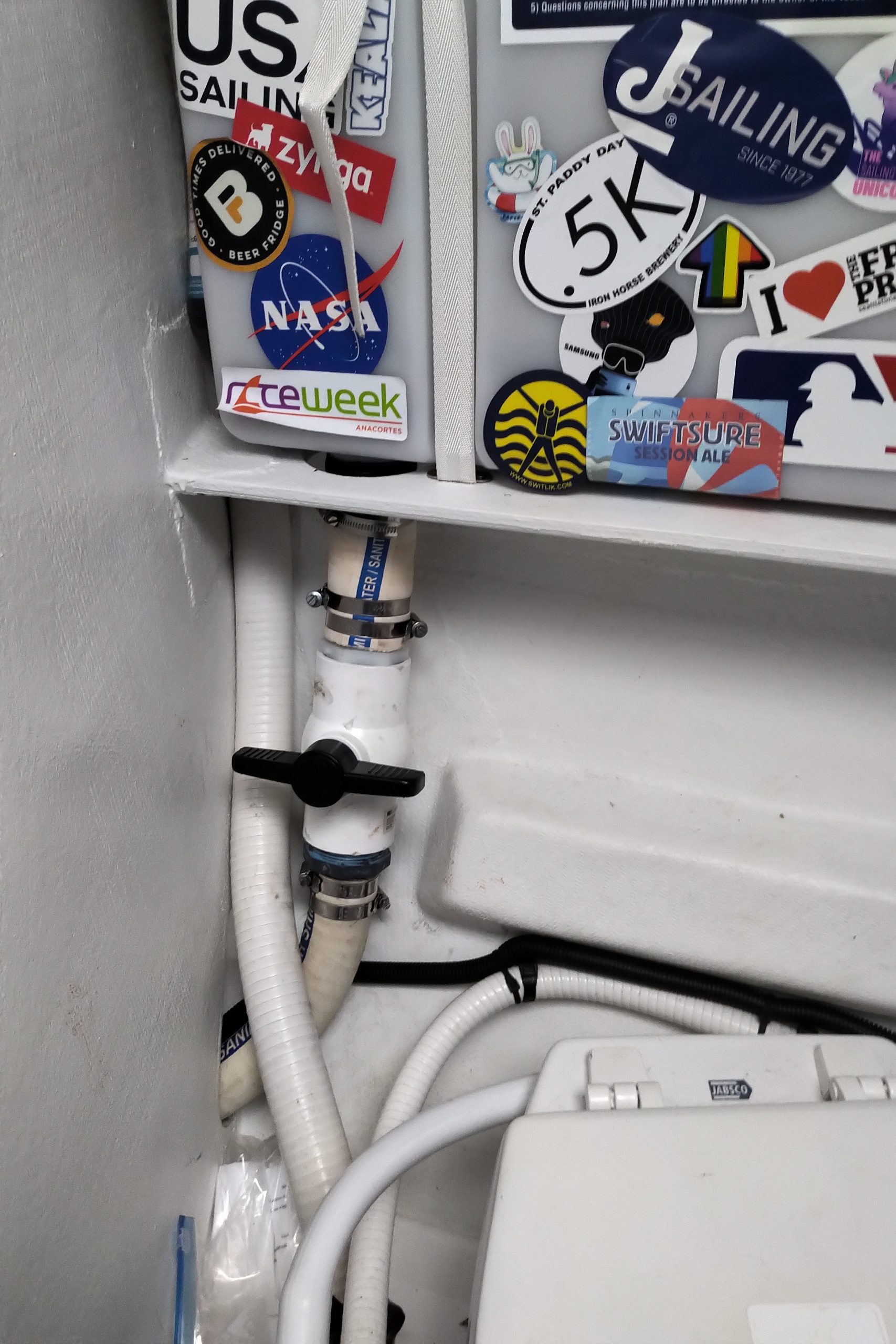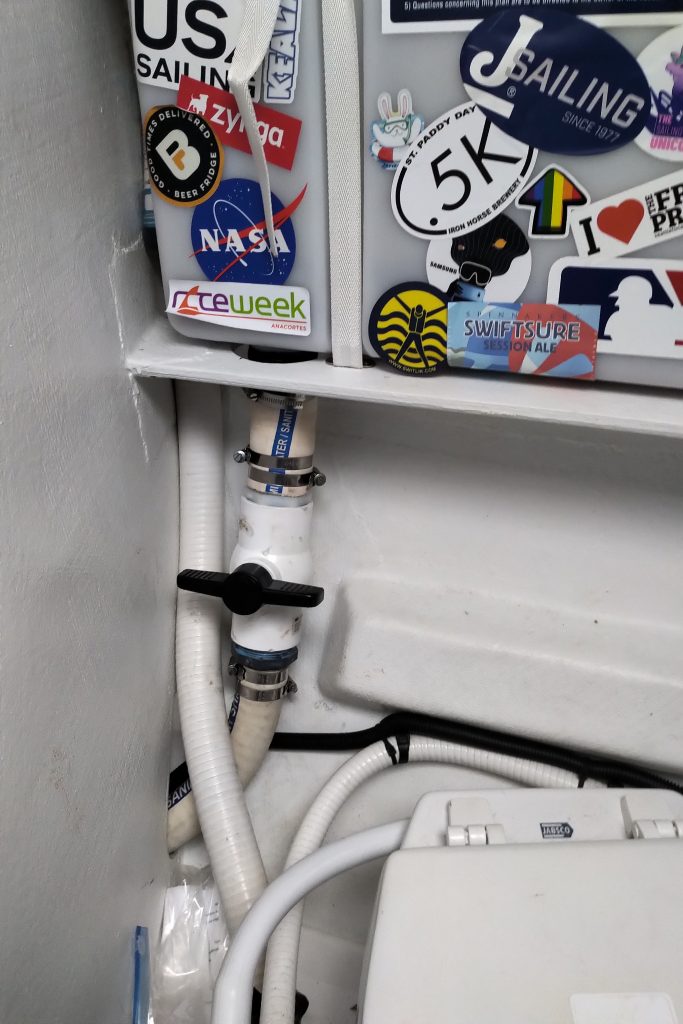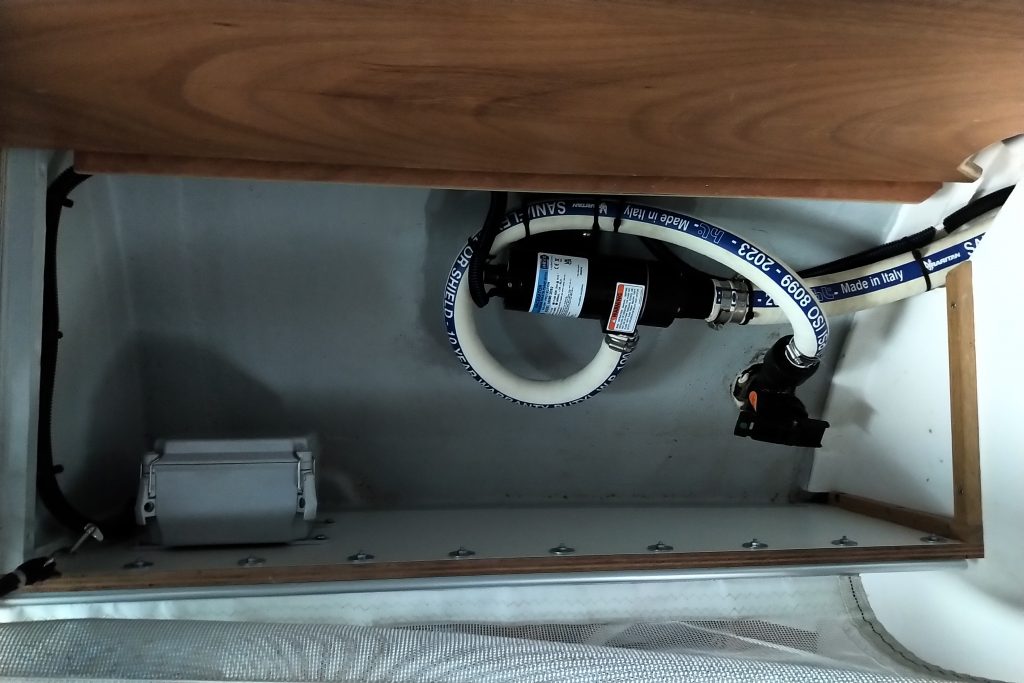

It was a busy offseason for One Life, with many projects to be completed to address long-standing issues nagging me and my crew since she splashed four years ago today. I gave a long list of stuff to Nigel, Greg, and the crew at CSR Marine and they went to work.
Black water system
When you pay the kind of 6-figure money anyone buying a J/99 new pays, I think there is an expectation the black water system works.
Newp.
The smell was the worst of it, to start. Between the tank and the through-hull, there is about a meter of hose. Since we are prohibited by law from draining black water into Puget Sound, we empty the tank via pump-out stations. These work great, but you’re never going to get what’s in that last meter of hose out.
So it sits. And smells. (And no, the quality of hose makes no difference. Trust me on this.)
The first solution was to block the outside vent with my hand while pumping out, creating suction in the tank. Then open the through hull and suck seawater from outside the boat to flush the meter-long hose. This worked fine, but didn’t really solve the problem.
So, I installed a big ball valve right below the tank and changed out (again) the saturated existing last meter of hose. This solved the smell problem, but…
Late one night while overnight racing outside of the no-drain zone, the head was full. We opened the through-hull to drain overboard and nothing — even when we over-pressurized the tank.

(Some of our favorite stickers added because, well, the black water tank is semi-translucent and who wants to see THAT?!?)
Figuring it was because I put in too small of a ball valve, I ripped it all out and added a new one.
Then during the VanIsle360 race, the head just quit draining. That’s a BIG problem since pumpouts are few and far between up along Vancouver Island. The crew had to resort to a piss jug — an upcycled Lysol wipes container. The bright side to this grim reality are the tear-inducing humorous stories which have now become a firm part of One Life legend.
The dark side is it turns out the through hull is engineered to be a one-way contraption. This makes sense, but the “suck the seawater through” method we used killed something in the valve, causing us to be stuck way offshore with no way to drain the head.
Determined to fix this, in the offseason everything after the ball valve was taken out (again) and I had a macerator pump installed. I have not been able to test it yet (Puget Sound rules and all), but I’m pretty confident we’ve conquered both the smell AND the drainage issues.

The water ballast that wouldn’t
The other potentially major project was to make the water ballast system something workable for the racing we do in Puget Sound. The base requirement was sub-1 minute fill and transfer, instead of the 7+ minute fills and 2-minute (if you’re lucky) the system currently does.
After having a series of internationally-recognized water ballast experts look at it, we made the decision to decommission the water ballast. The system as designed is, frankly, useless to us and to fix it would have taken $30k worth of custom hull and systems work — for two crew worth of weight.
Newp.
This decision will save us a couple seconds on our ORC rating, which is one silver lining. We left everything in place so we wouldn’t have to get re-rated, simply disconnecting a couple of hoses and zip tying the inlet closed.
The second silver lining comes when I had the great folks at CSR Marine install a Category 2 offshore compliant permanently installed manual bilge pump below decks. That was made MUCH easier by taking advantage of the outflow system for the water ballast!
Rig geometry
From the beginning, we’ve been fighting the sail trim on One Life. There’s a long story behind this, but suffice it to say it’s been a big competitive pain in my ass.
My original sail loft closed in 2023, so I took the opportunity to have Alex Simanis from Ballard Sails and Greg Barckert from CSR get fresh eyes on everything. Alex came out for a test sail and he and Greg came up with new tension and mast shape we think will help. We also significantly tightened the forestay — which has always been something I (and several of my crew) thought was necessary.
Will this make us faster with the current sail plan? Only time and more work will tell. I’m hopeful, though, and really excited to find out.
Outhaul fiasco
With our oversized main, the outhaul has always been tough to use. In any breeze over about 8 knots, we have to luff up to get the outhaul on tight. During the last race of the season, the cover split off the dyneema outhaul line.
I figured this was one thing I could handle myself, so I climbed the ladder up to the boat while she was on the hard and got to work. I tied the messenger line on to the loop in the back of the boom that normally attaches to the clew of the main. Then I managed to get my fingers in the narrow space between the front of the boom and the mast and untied the bowline there. (Pretty proud of myself for that, actually!) I pulled and pulled, and the end of the outhaul dropped into my lap.
Without the messenger line.
Well, fuck.
Turns out, the outhaul is two lines running through all the blocks in the boom, not one.
Thankfully, Ned from CSR had me covered. The day I was visiting the boat and working with him and Greg to figure out some of the rig gemoetry issues, he pulled all the blocks out in preparation for fishing all the lines back though.
Again with the silver linings, two of the blocks in there were pretty badly damaged and likely would have failed this season. We upgraded all the blocks and Ned put it all back together for me.
Which brings me to another point about the J/99. The boat is a champ, but there are a number of places where the stock blocks are not quire enough to handle the loads involved with the intended sail plan. This outhaul experience highlights one. I’ve written here before about the need to upgrade the backstay blocks (and the bowsprit). We blew out a spinnaker sheave this past season, too, so there’s another upgrade we made (though I think that’s less OEM and more hard use). Todd Aven has pretty much redesigned his jib system on Thin Man to address this issue and a pair of local J/99’s had spin and jib blocks explode on them in the back of the boat.
I know many folks who are looking to buy a J/99 end up finding this web site. I’d never suggest any of the above is a reason not to buy one. Joining the 150+ boat J/99 worldwide fleet is a great decision because she’s a great boat. You just need to keep a close eye on a few things and take some preventative steps.
That’s it for now, folks. Sail safe and sail fast!
